
Willey House Stories Part 22: Calling the Kettle Back—Chapter 7: Repatriation
Steve Sikora | Feb 17, 2023
In this seven-chapter subseries of the Willey House Stories, Steve Sikora reflects on Frank Lloyd Wright’s fireplaces, their purpose, and meaning—and the search for one missing kettle. You can read the previous chapters by clicking on the links at the bottom of this post.
Remember where this story began, with that missing Willey House kettle?
As I said, I could never entirely give up hope. But at one of those times when all apparent avenues of investigation seemed exhausted, we did what law enforcement does in such situations. We turned to a psychic. Judy was a highly religious figure who resided in rural Florida. She was bestowed with the gift of second sight. Lynette and I consulted with her by phone on occasion and we trusted in her insights immensely. Judy once declared, out of the blue, there was “a house we would buy at the end of a long road, near cold water. The old man who owned it wanted us to have it.” Lynette and I puzzled over her statement for years before we found ourselves one day, driving up the quarter mile, tree lined, double track that led to the door of a rustic, 1915 Arts & Crafts home.
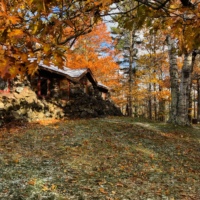
The house at the end of a long road, near cold water as foretold—like the mythical pot of gold at the end of a rainbow. Credit: Steve Sikora
It was surrounded by forest, orchard, and meadow, nestled into a retreat center. Before the second growth forest regenerated itself, the small lodge had been sited with a dramatic vista of the Chequamegon Bay of Lake Superior, a very cold body of water. The old man, whose name incidentally was Bob, turned out to be the founder of a retreat center, the house was surrounded by. He was at the moment of our approach, in dire need of identifying exactly the right buyers for the beloved home he needed to surrender.
Our psychic had interesting things to say about the Willey House too. One phrase that obliquely surfaced during a phone reading was “they’re watching over that house.” Who “they” were she was unable to explain.
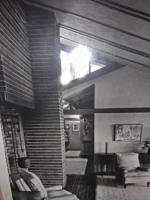
The Willey House circa 1960s showing the kettle in the fireplace. Credit: Burris family
But I agree with her assessment, somebody up there has certainly had our backs on a number of occasions when mere misfortune could easily have quickly escalated to total disaster. An intriguing phrase that came through one of her readings was delivered as an urgent pronouncement. Almost a command, “Don’t get rid of the cast iron!” Judy the psychic had absolutely no idea what it meant and asked me if I did. Intuitively, it could only mean one thing in my mind, and that was the lost cast iron kettle. I can’t explain the inference, only that it was precisely what I felt when she uttered the words. I read back the notes of her reading repeatedly, wondering about Harvey Glanzer’s crappy kettles and other objects in the house that were made of cast iron, of which there were none, other than broken radiators. Over and over I came back to the wayward kettle as the point of her reference. “Don’t get rid of it!” she repeatedly warned. But how can I throw it away when I didn’t know where it was? I realize now that the dire warning was not directed to me in any actionable sense, although I was supposed to receive it.
Thrilled by its unending potential, the psychic’s bewitching phrase never ceased to nag at me. Rolling it over in my mind, I perceived it as a clue, one that revitalized my periodic searches. Something about this kettle business, though perennially unresolved, felt tantalizingly imminent.
Between spikes of optimism, I worried the kettle was another lost cause—just something else to file away with numerous nausea-inducing deficits that plague the obsessive completist in me. Among them; the original couch design (Nancy requested one in October of 1937), the Cabot’s stain sample chart showing our true stain color, a lost interior furnishings color palette, The Great Wave block print by Hokusai, and the several missing photos removed from Nancy Willey’s photo album. I could go on and on. All are now gone, forever probably. But I’ve learned time and again, one should never say never, because remarkable things do happen. “They” are, after all, watching over.
I was sure I had asked the second owners of the Willey House, Russell and Jane Burris about the kettle when we met one afternoon in 2003. At the time we were neck deep in the quicksand of our restoration and I had hundreds of questions for them. What if that particular question was never asked?
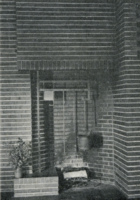
Willey House fireplace as published in the July-August 1969 issue of Northwest Architect. Proof that the kettle remained post occupation by the Willeys. Credit: John Howe
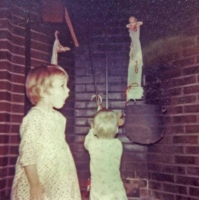
Julia and David Burris hang Christmas stockings in the fireplace. The kettle was already showing some rust. Credit: Burris family
Russell and Jane raised three young children in the house: Julia, David and Lydia. This, the next generation of Burris family members have been ardent supporters of our efforts to restore the house and reassemble the archives. I decided to email David Burris and ask if he recalled the kettle from his childhood. To my shock and delight, he reported, “I do remember a black pot—quite possibly this same pot—at/near/hanging from the fireplace. If it’s the one I’m thinking of, my family may still have it. My younger sister (Lydia) thinks it’s in her storage shed, on the property (in Coon Rapids) where my family had a summer cabin, but where she now lives in a year-round house. It was a property John and Lu visited many times…Whether my family’s black pot is this same one or a reasonable replica, isn’t clear.” Holy Jesus in a Jeepster! What did he just say? Reading his response made my head ring like a bell struck with a cartoon mallet. Could he have just said what I think he said?
The Burris family owned a small retreat in Coon Rapids. Now considered a northern suburb of the ever-expanding Twin Cities metro, it was back then a lake cabin, the fever dream of every Minnesotan seeking to fully exploit the glorious summers of the upper Midwest. The Burris cabin was just a 30-minute drive from Minneapolis but a world away. The “John and Lu” who David referred to were John and Lu Howe, former Taliesin apprentices, come friends of Jane and Russell Burris as well as frequent guests.
In a follow-up email David told me, “Lydia said the kettle is in a storage shed and isn’t easily accessible until after the snow melts. Is it ok if she waits until then? It also sounds like we could return this to the house if that’s where it belongs. In the meantime, we’ll look for photos of it to pass along.” Could I wait? Are you kidding? I feel like I’ve waited my whole life for this. Hell yes, I’ll wait!
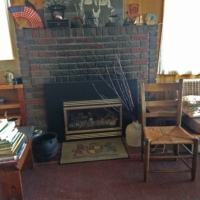
The Willey House kettle, next to the fireplace in the Burris lake cabin, in Coon Rapids, Minnesota, where it resided for decades. Credit: Burris family
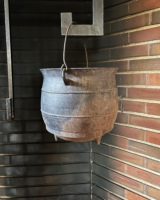
The original kettle in close up. Credit: Steve Sikora
Unbeknownst to the Minneapolis preservation community and preceding guardians of the Willey House, the elusive kettle sat undetected for decades in the Burris family lake cabin—any association with Nancy Willey long forgotten. But the story gets stranger. In spring of 2017 the cabin was sold. It was literally trucked offsite by a new owner to Breezy Point, Minnesota, a vacation destination, two and a half hours away. Lydia and her husband retained the land to build a home of their own. Our spooky admonition, “Don’t get rid of the cast iron!” came through in January 2015. I answered, but that call from the ether was meant for Lydia. She may have been unwittingly on a psychic party line, because on a whim, she retained the kettle and deposited it in a storage shed where it patiently gathered dust, awaiting its reunification with Nancy’s house.
When asked why her parents took the kettle in the first place Lydia said, “I’m not sure it was intentional. I’m wondering if moving with three kids after returning from sabbatical if it just got moved with everything (by someone helping).”
The Burris family move from the Willey House took place at the end of a sabbatical in Stony Brook Long Island, New York. Upon returning, they spent the summer at their cabin just before the house keys were turned over to Harvey Glanzer. It is suspected a volunteer mover may have grabbed the iron kettle while extracting the last of the family’s possessions.
The morning Lydia and her kids delivered that beautiful old kettle to the Willey House was a day of exultant joy and gratitude. I have no words for their kindness. The fireplace at last feels complete again, just as it did in those classic photos. Its replacement on the crane even subtly affects the perception of the scale of the room.
Home after an absence of 49 years, the prodigal cauldron does not give up its secrets easily when it comes to its origin. The metal casting shows no signature or brand name. The Willey House kettle has only one marking at the bottom of the bowl, the number “6.” The kettle bears a linear casting scar visible along the underside of the pot, known as a gate mark. It is an artifact of the sand casting process used in its manufacture. The presence of a gate mark, the wire bail handle, and the shape of the “ears” that clasp the handle are all indicative of a kettle manufactured in the 19th century. A numeral in the casting can indicate a date of manufacture, a model number, or a diameter measurement. The number 6 marked on the bottom of the bowl is likely some sort of size designation, possibly meaning a 6-quart volume. Beyond its approximate age, nothing else is currently known.

The original kettle returned to the Willey House fireplace 49 years later. Credit: Steve Sikora

The only identification on the kettle is the numeral 6 on the underside of the bowl. Credit: Steve Sikora
In period photos the kettle displays a distinct sheen. That luster could be attributed to a pot being seasoned with oil for cooking, but now that I have seen it firsthand, it’s clear the kettle wears an ancient coat of black enamel. Cast iron collectors dread a painted surface because one cannot cook in a painted pot or pan. According to Paula Marcoux, it is sometimes done when cookware is retired from use and relegated to a purely decorative purpose. Which I suppose this one was, at least since 1934. Whether or not Wright meant his fireplaces to cook in or not, the Willeys decidedly did not hazard it. So, with this revelation, another question arises. Do I season or repaint in my restoration of the kettle?
After a lengthy period of reflection, mostly recounted in this article, I’ve concluded that the kettle should be seasoned. After all, one can never know when some cooking might need to be done over the fire.
READ THE REST OF THE SERIES
Part 1: The Open Plan Kitchen
Part 2: Influencing Vernacular Architecture
Part 3: The Inner City Usonian
Part 4: A Bridge Too Far
Part 5: The Best of Clients
Part 6: Little Triggers
Part 7: Step Right Up
Part 8: A Rug Plan
Part 9: Hucksters, Charlatans, and Petty Criminals
Part 10: Lo on the Horizon
Part 11: Origins of Wright’s Cherokee Red
Part 12: One Thousand Words
Part 13: The Plow that Broke the Plains
Part 14: Separated at Birth
Part 15: Trading Drama for Poetry
Part 16: A Red By Any Other Name
Part 17: Roll Down to Levittown
Part 18: Cherokee Red The Rejoinder
Part 19: Nothing Lasts Forever
Part 20: The Struggle
Part 21: Giving What They Had to Give
Part 22: Calling the Kettle Back—Chapter 1: The Kettle
Part 22: Calling the Kettle Back—Chapter 2: The Crane
Part 22: Calling the Kettle Back—Chapter 3: Plagued By Fireplaces
Part 22: Calling the Kettle Back—Chapter 4: A Heritage of Cooking Fires
Part 22: Calling the Kettle Back—Chapter 5: Benefits of the Fireplace
Part 22: Calling the Kettle Back—Chapter 6: Transcendental Flame
Part 22: Calling the Kettle Back—Chapter 7: Repatriation

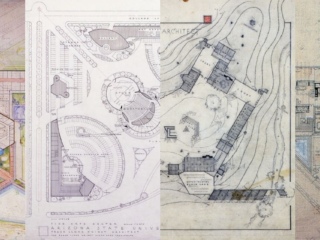
![[Cohen House Tropical Foliage (Abstract Pattern Study), Eugene Masselink, ca. 1957, graphite, ink, and paint on plywood, Frank Lloyd Wright Foundation Collection, 1910.223.2.]](https://franklloydwright.org/wp-content/uploads/2024/04/1910.223.2-2-a-320x240.png)
